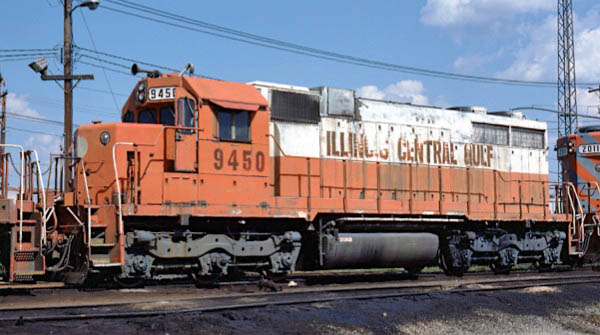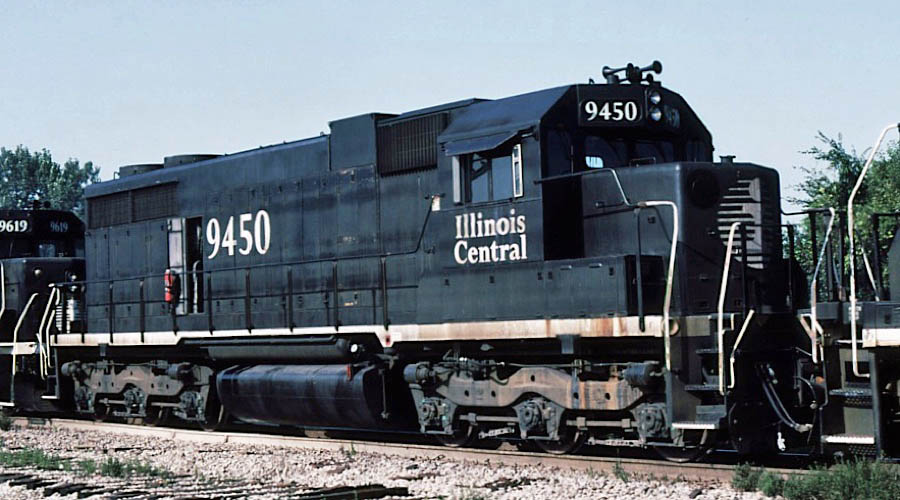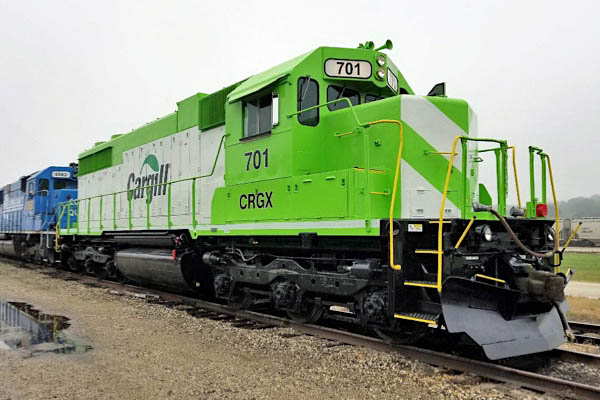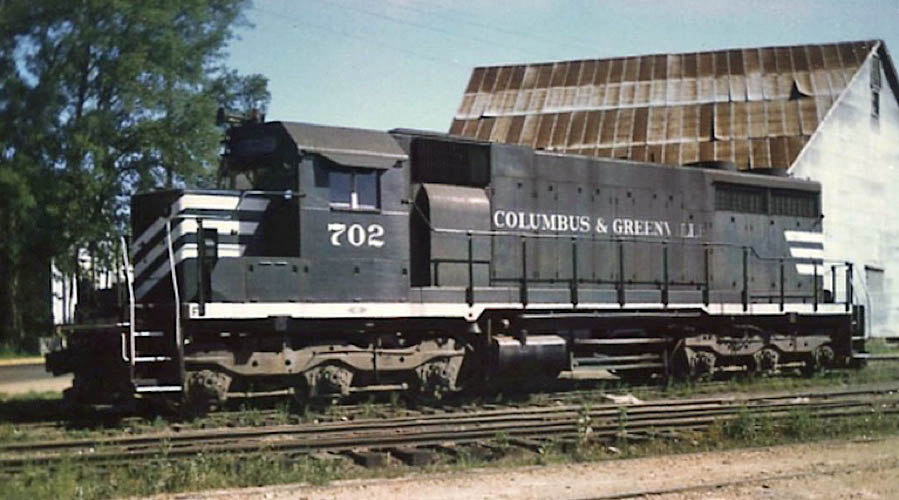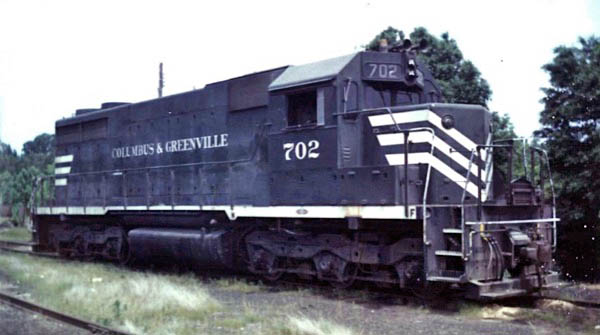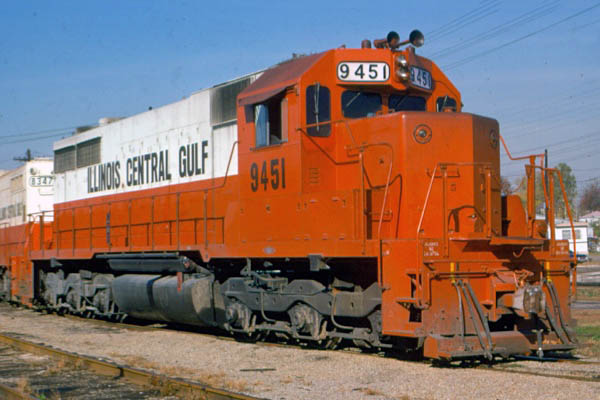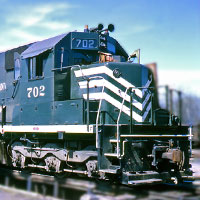 |
Columbus & Greenville Railway Special Duty Twenty Eights |

By the latter part of the 1960's the C&G was operating one freight train a day each way over the line. Timetables of the era show that about eleven hours was scheduled for the trip, but trains often crept from terminal to terminal in sixteen hours. To provide for more horsepower on these long trains and to make up for the loss of the 602, C&G purchased two modern 1800 horsepower SD-28 road switchers from the Electro-Motive Division of General Motors in September of 1965. These locomotives, No. 701 and 702, had the distinction of being two of just six locomotives of their type ever built and gave a de- cidedly modern appearance to the property. More importantly, they allowed an increase of about nine hundred tons in the weight of trains leaving Columbus with one unit. The new locomotives were quite an improvement over the old Baldwins ...
Louis R. Saillard — Delta Route: A History of the Columbus & Greenville Railway, 1981

Greenville, Ms / April 1970 / collection
 By mid 1960s, the Columbus & Greenville's famous Baldwin fleet — first of its kind in the nation — was well into middle-age years and showing limitations. Baldwin #602 had been knocked out of service by a terrible derailment near Maben in 1961, and C&G crews were struggling to add tonnage to the daily freights that plied the rails between the road's namesake terminals. Consequently, in the fall of 1965 the C&G purchased from General Motors' Elctro-Motive Division a pair of handsome SD28s: 1800 horsepower road switchers riding on 3-axle trucks. In the same way that the Baldwins gained notoriety for being first in a small batch of early BLW road switcher models, so too the new SD28s claim a noteworthy position among a handful of units produced in this series. Only six SD28s were produced by EMD during a two-month span in 1965. Reserve Mining was the only other customer. Unlike the C&G units, the Reserve units were ordered with dynamic brakes and full-size fuel tanks. Together with the more popular subsequent SD35 model (360 units produced), the SD28 represents EMD's maximization of its venerable 567 prime mover. Subsequent SD units carried the 645, the next generation of prime mover in the EMD motive power evolution.
By mid 1960s, the Columbus & Greenville's famous Baldwin fleet — first of its kind in the nation — was well into middle-age years and showing limitations. Baldwin #602 had been knocked out of service by a terrible derailment near Maben in 1961, and C&G crews were struggling to add tonnage to the daily freights that plied the rails between the road's namesake terminals. Consequently, in the fall of 1965 the C&G purchased from General Motors' Elctro-Motive Division a pair of handsome SD28s: 1800 horsepower road switchers riding on 3-axle trucks. In the same way that the Baldwins gained notoriety for being first in a small batch of early BLW road switcher models, so too the new SD28s claim a noteworthy position among a handful of units produced in this series. Only six SD28s were produced by EMD during a two-month span in 1965. Reserve Mining was the only other customer. Unlike the C&G units, the Reserve units were ordered with dynamic brakes and full-size fuel tanks. Together with the more popular subsequent SD35 model (360 units produced), the SD28 represents EMD's maximization of its venerable 567 prime mover. Subsequent SD units carried the 645, the next generation of prime mover in the EMD motive power evolution.
Nos. 701 and 702 served the Delta Route quite well, allowing for increased train tonnage leaving Columbus and shorter travel times for movements across the state. In fact, it is quite likely that these two locomotives would have enjoyed a long career on the Mississippi shortline, except for an ill-timed wreck and the coming Illinois Central Gulf absorption. In late 1971, the two SDs were involved in a bad grade crossing accident at Kilmichael. Less than five months after their return from Paducah Shops, the beleaguered C&G was officially absorbed into the new ICG system. Although the ICG would retain ownership of the Delta Route for less than two years, much of the better equipment left the C&G for work elsewhere on the new Class 1 system — the two SD28s, prime examples. Their small shortline tanks were quickly upgraded by the ICG for mainline use, and soon could be spotted in mainline lashups all around the southern region of the ICG system. When the CAGY formed again as an independent operation in 1975, purchasing the line back from the ICG, 701 and 702 did not return to Columbus. They carried on even beyond the ICG, both receiving the black paint of the subsequent Illinois Central, second edition.

SD28 roster notes / JCH
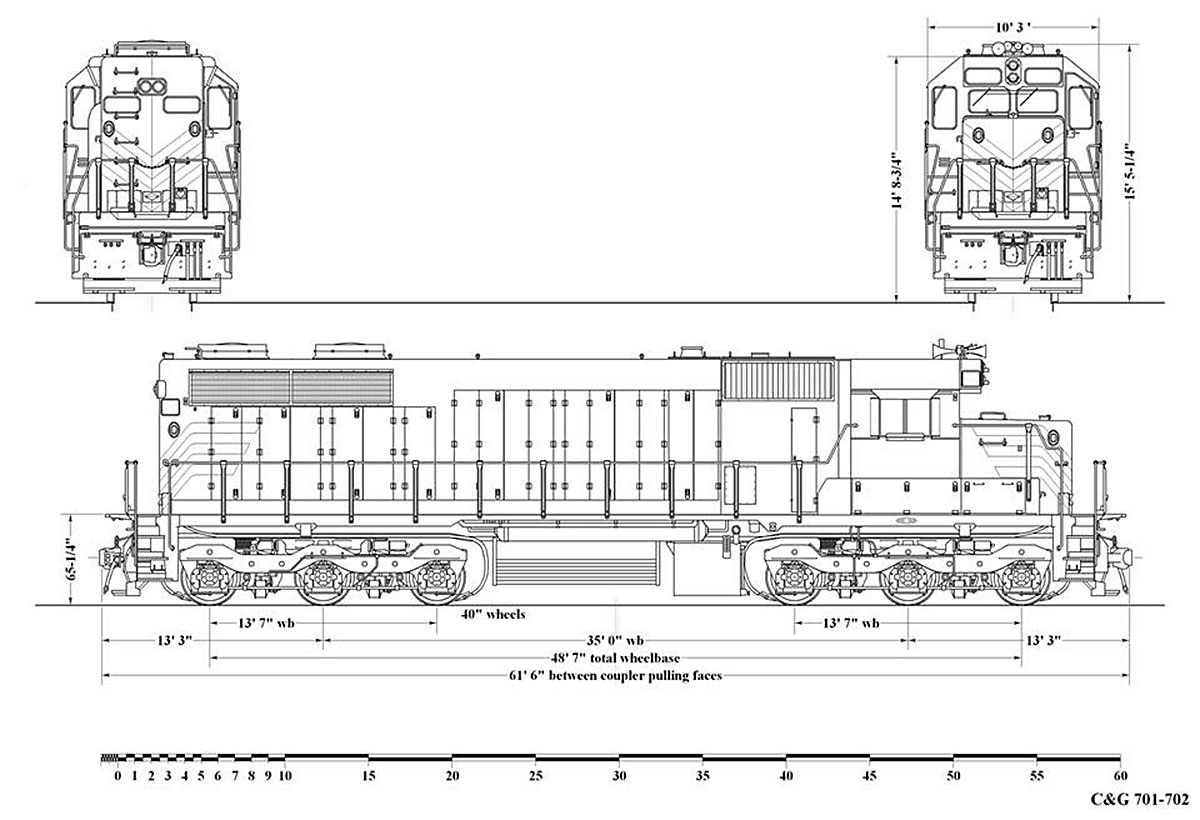
SD28 drawing / collection
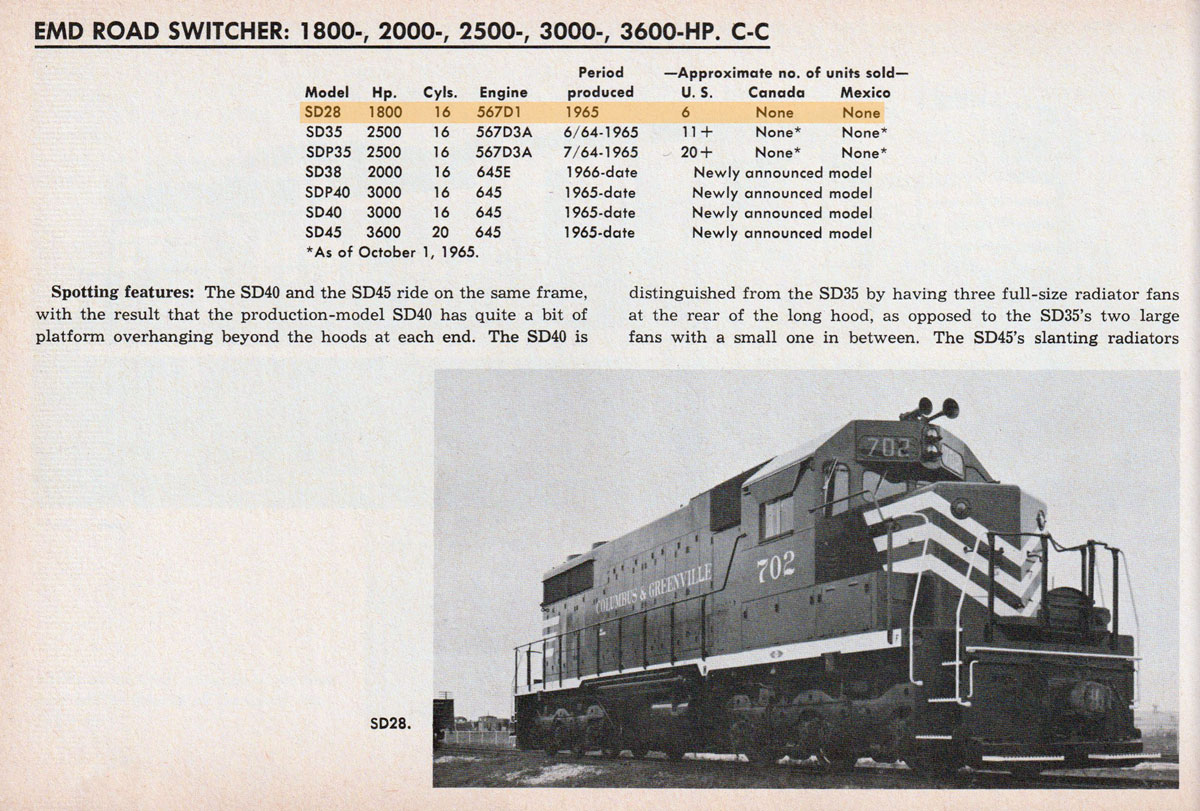
from Diesel Spotter's Guide
- Jerry Pinkepank - 1967 / collection
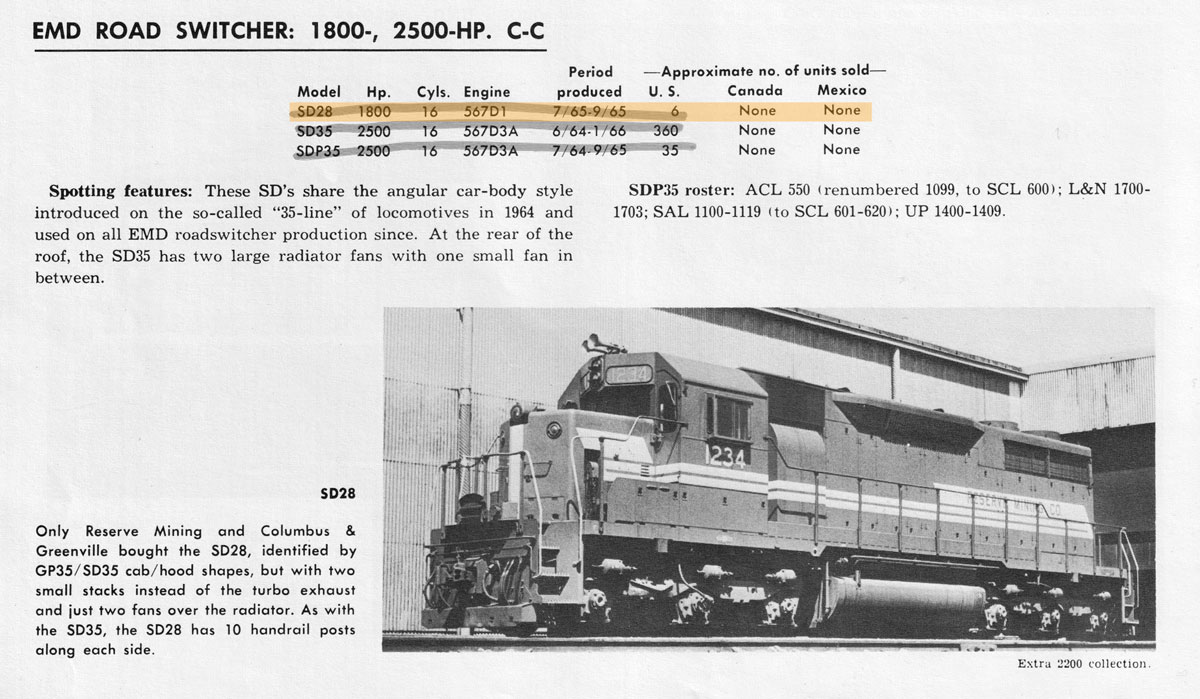
from The Second Diesel Spotter's Guide
- Jerry Pinkepank - 1991 / collection

See also our EMD GP28 / SD28 series scrapbook in Lagniappe
#701

 UNCOMMON or UNUSUAL locomotive
UNCOMMON or UNUSUAL locomotive
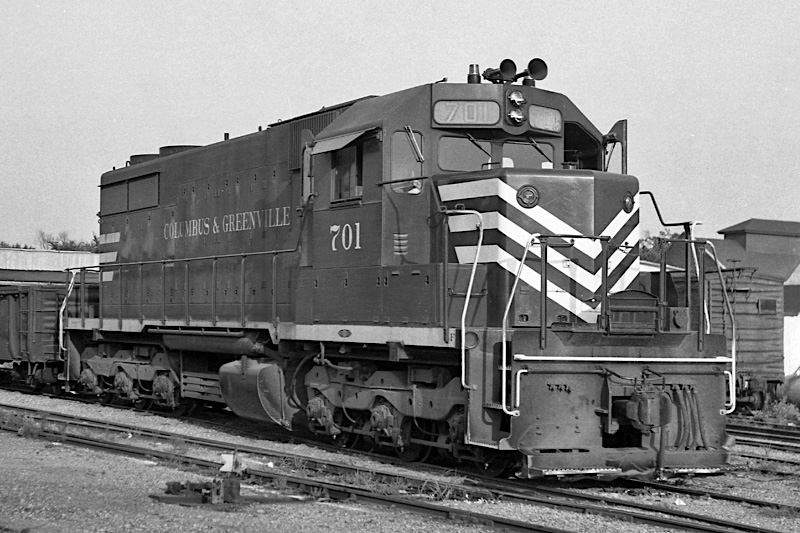
Columbus & Greenville #701
Columbus, Ms / Jun 1970 / JCH


Columbus & Greenville #701
normally aspirated, no turbo
to Illinois Central Gulf #9450, 1973
to Illinois Central #9450
to National Railway Equipment
to Cargill Incorporated #701


this locomotive also posted in illinois central gulf motive power
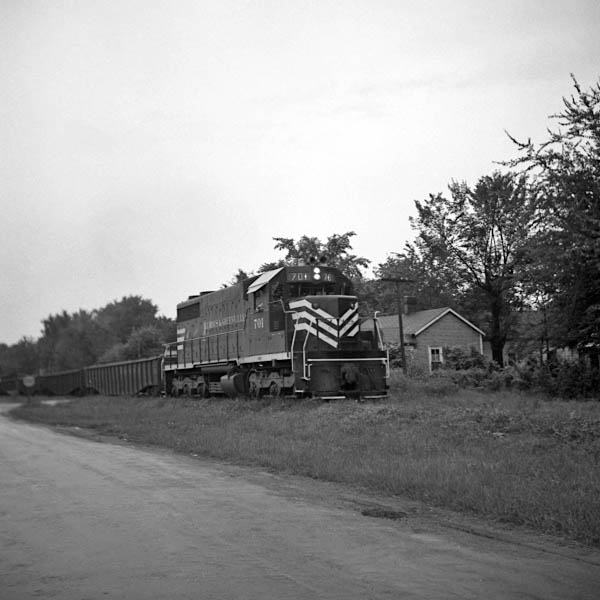
Columbus, Ms / Aug 1967 / JCH
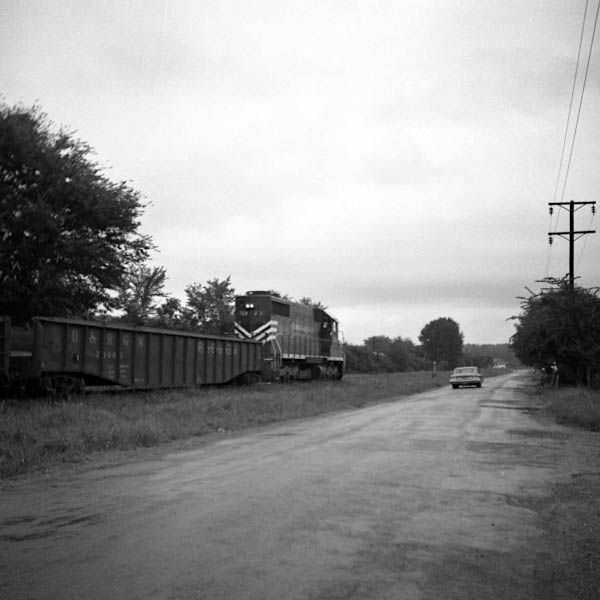
Columbus, Ms / Aug 1967 / JCH
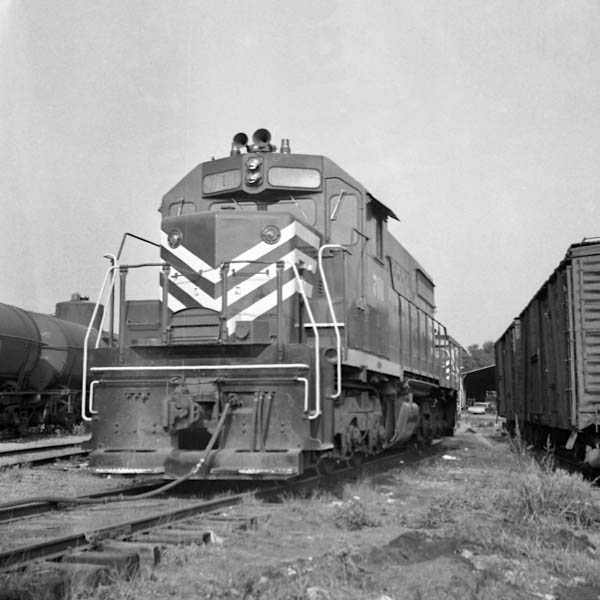
Columbus, Ms / Dec 1969 / JCH

Columbus, Ms / Dec 1969 / JCH
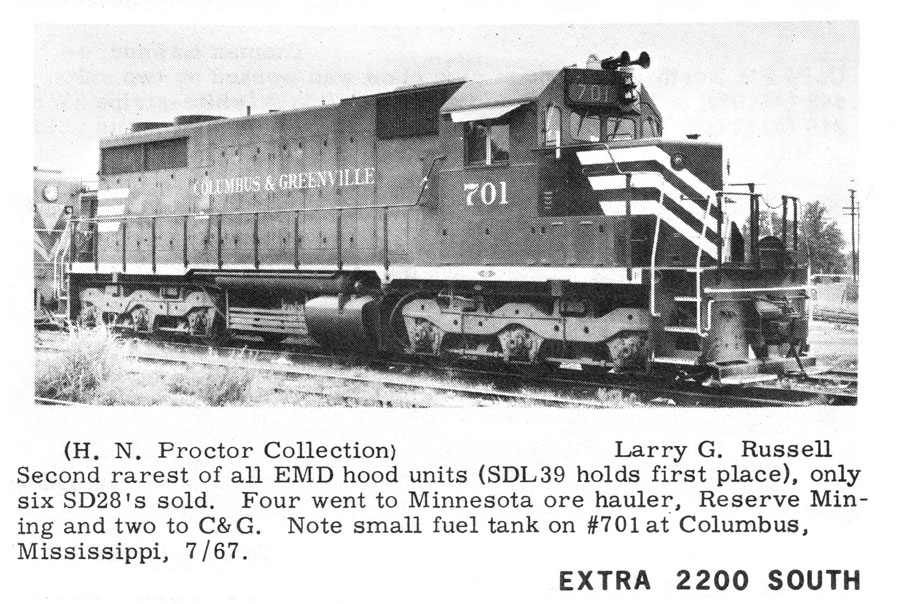
from Extra 2200 South
magazine - Oct 1971 / collection
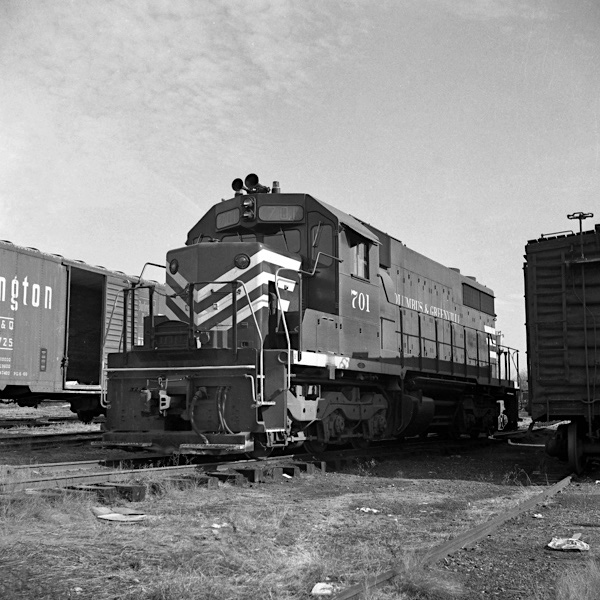
Columbus, Ms / Dec 1969 / JCH
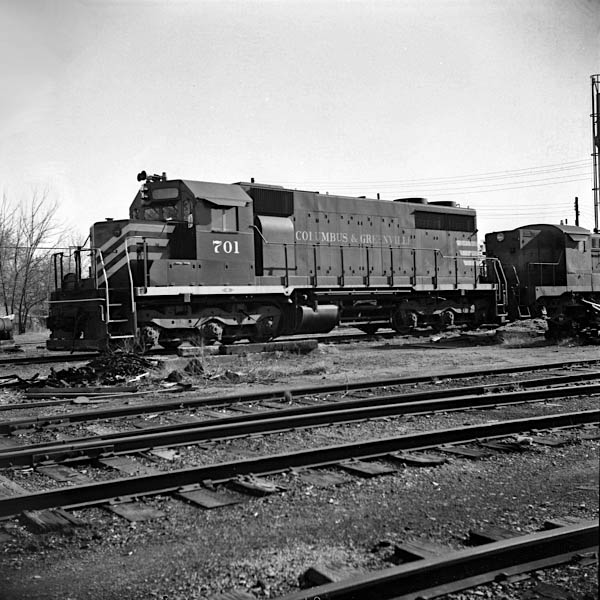
Columbus, Ms / Mar 1973 / JCH
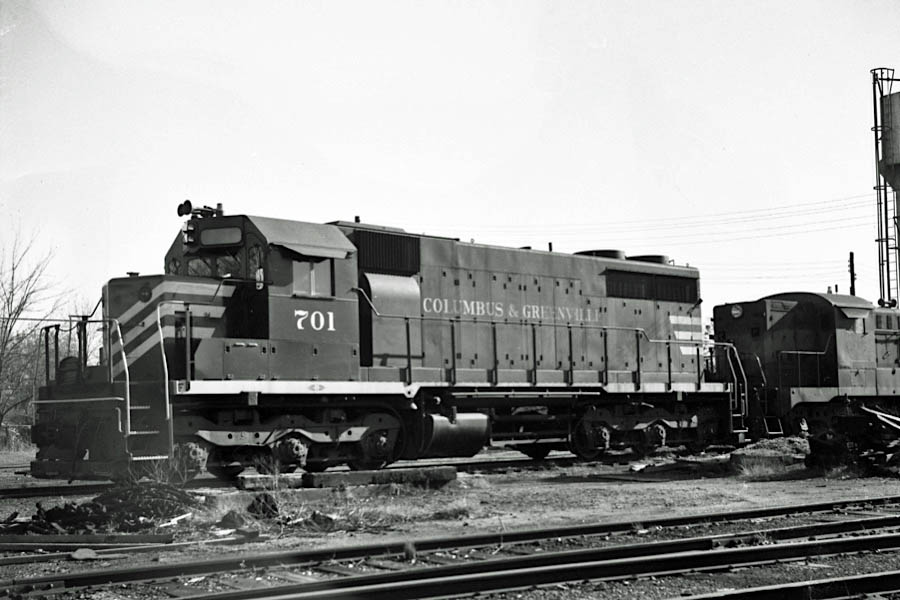
Columbus, Ms / Mar 1973 / JCH
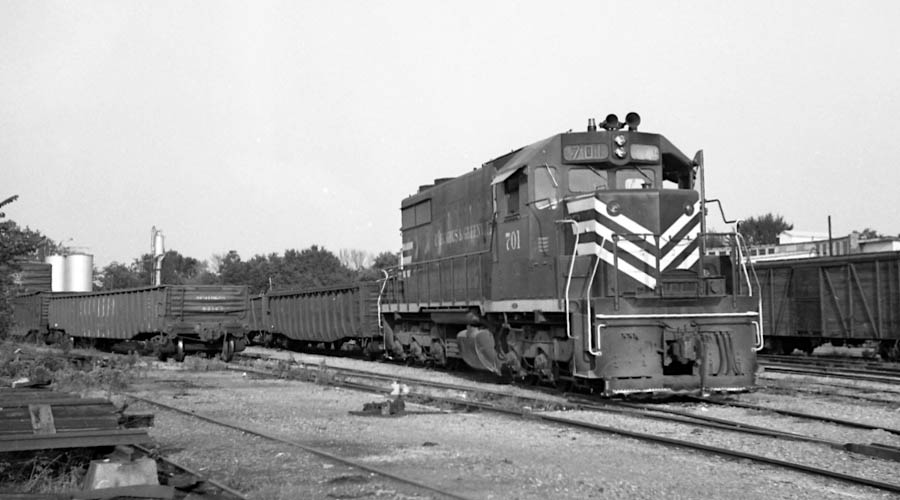
Columbus, Ms / Jun 1970 / JCH
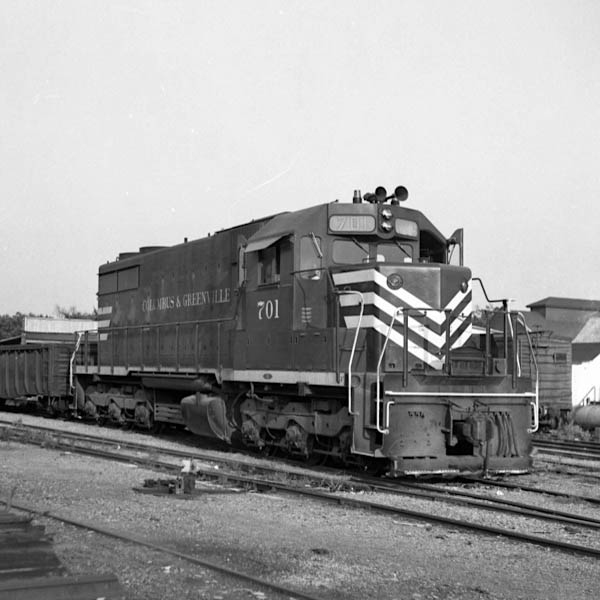
Columbus, Ms / Jun 1970 / JCH
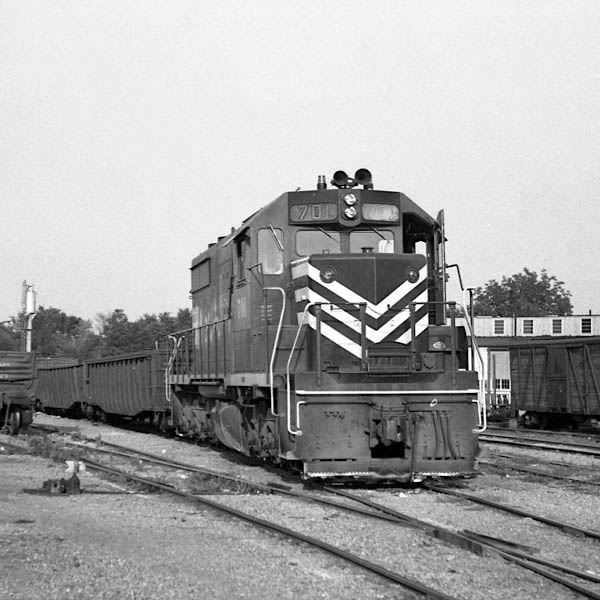
Columbus, Ms / Jun 1970 / JCH

Columbus, Ms / Jun 1970 / JCH

Columbus, Ms / Jun 1970 / JCH
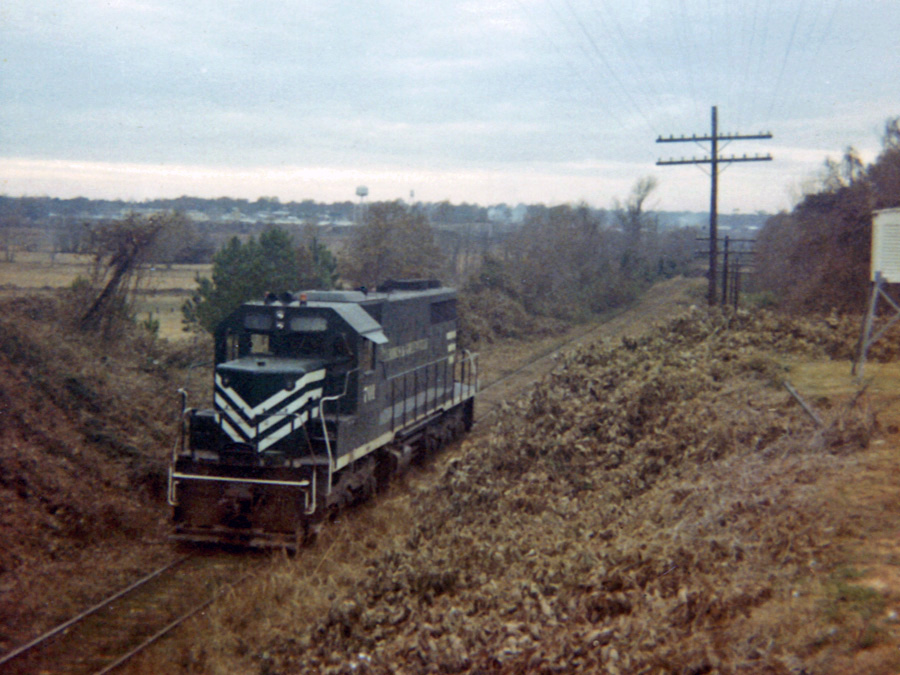
Nov 1970 / JCH
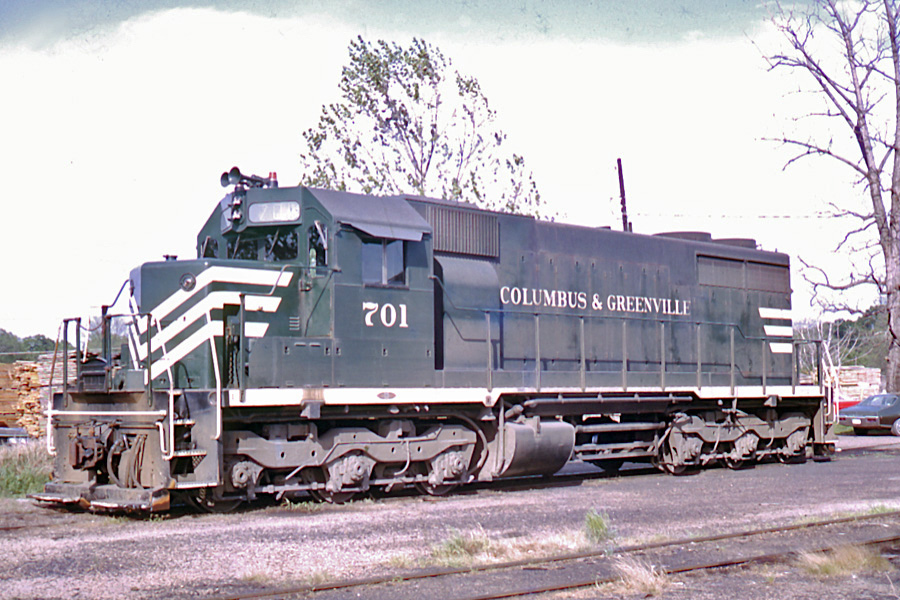
Greenville, Ms / Apr 1970 / collection
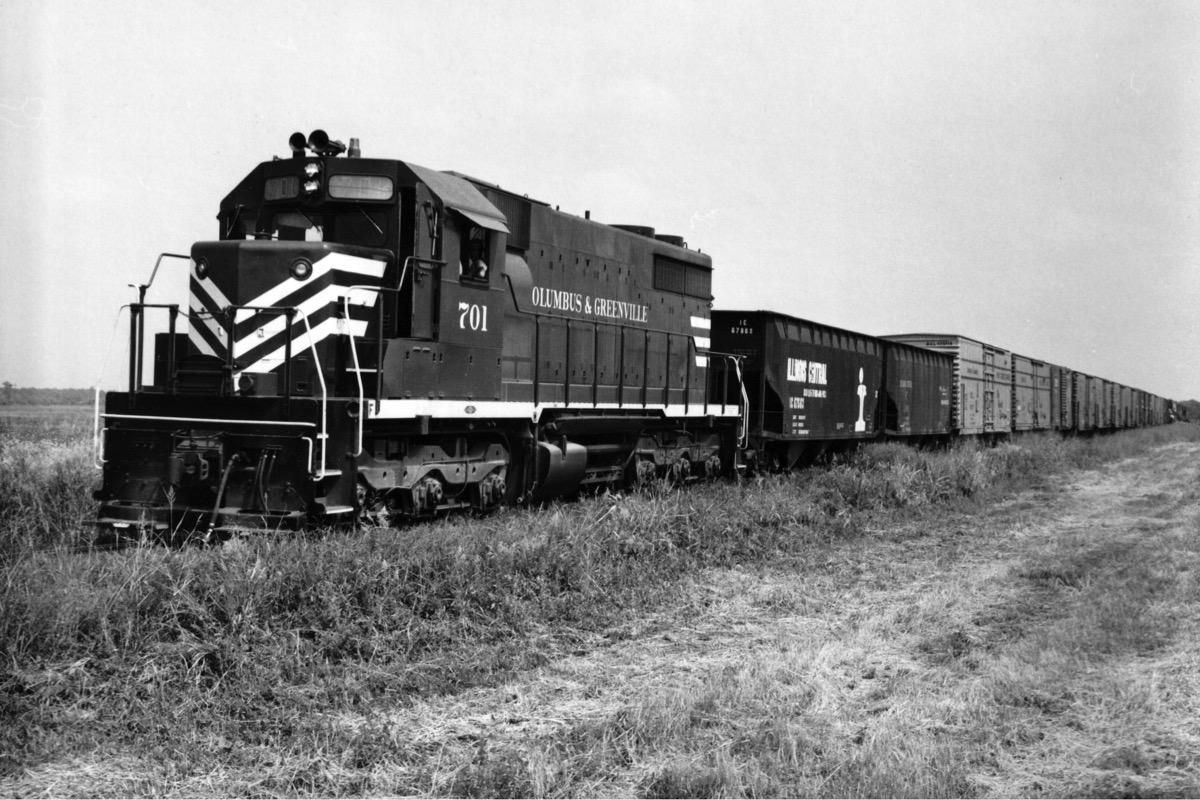
Sibleyton, Ms / Sep 1972 / collection
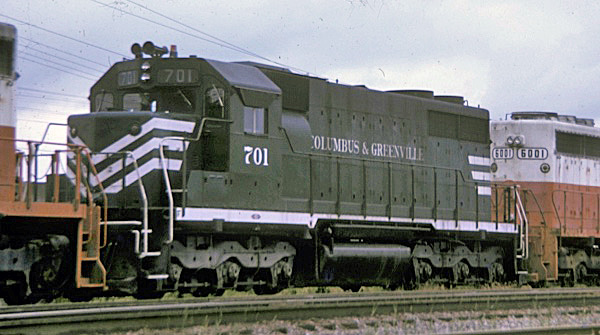
Gilman, Il / 1973 / collection
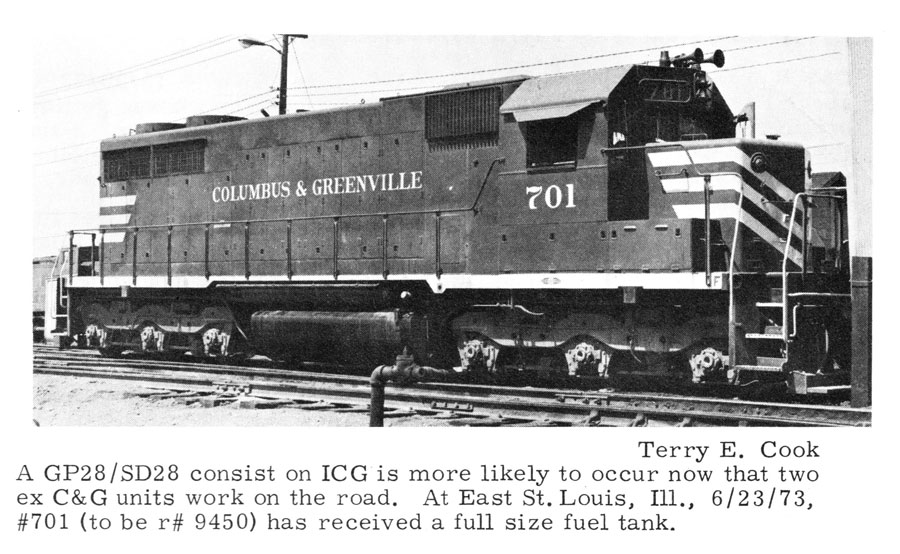
from Extra 2200 South
magazine - May 1973 / collection
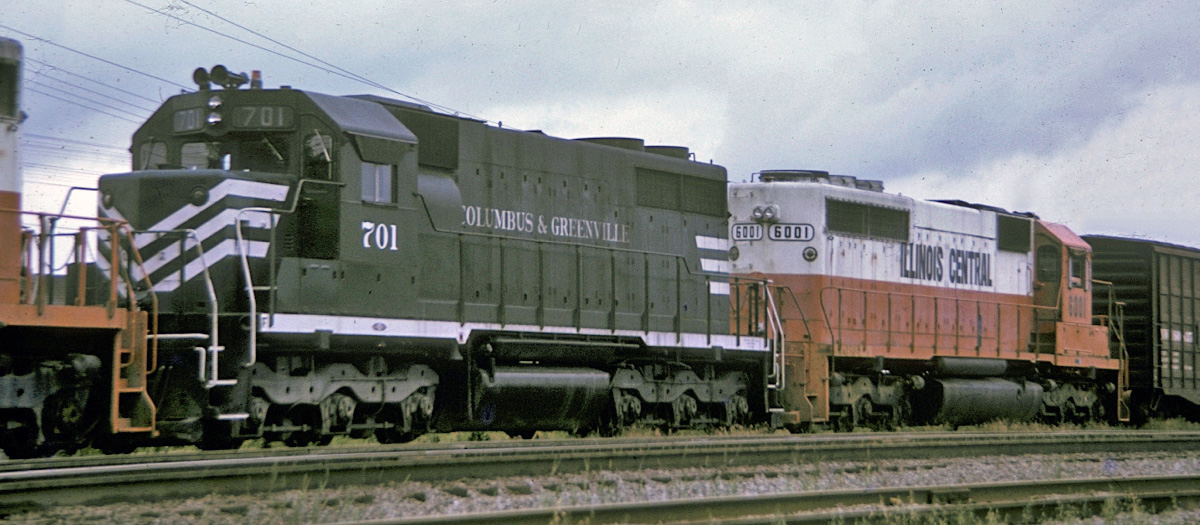
Gilman, Il / 1973 / collection
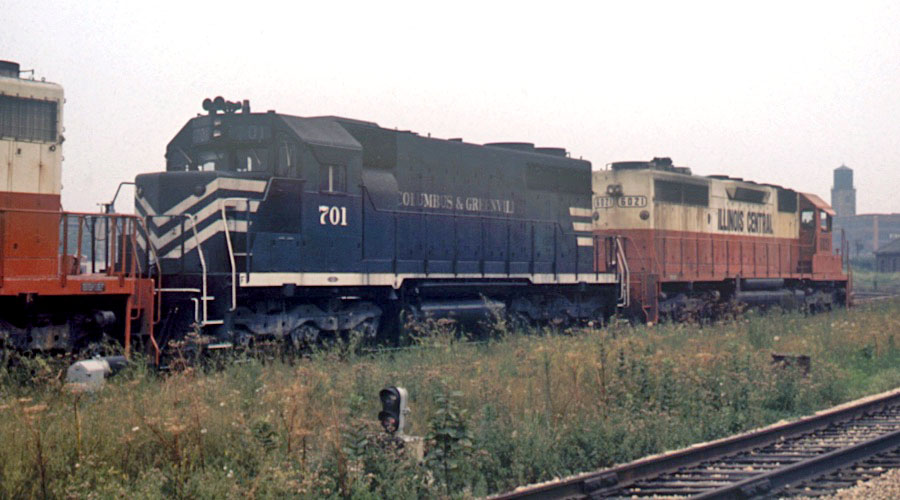
Chicago, Il / Jul 1973 / collection
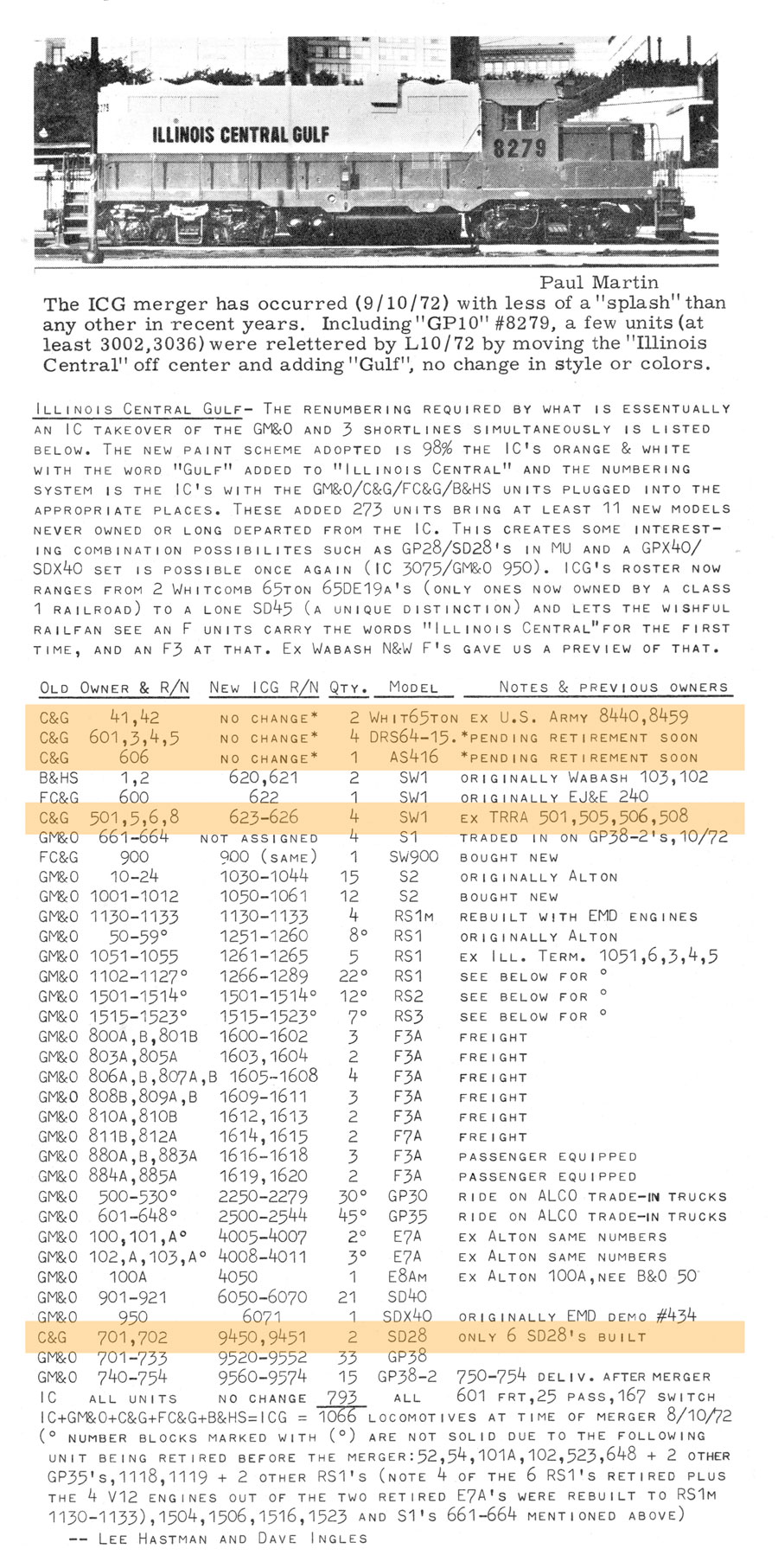
from EXTRA 2200 South
magazine - Sep 1972 / collection

See also our Illinois Central Gulf Motive Power scrapbook in Mainlines
#702

 UNCOMMON or UNUSUAL locomotive
UNCOMMON or UNUSUAL locomotive
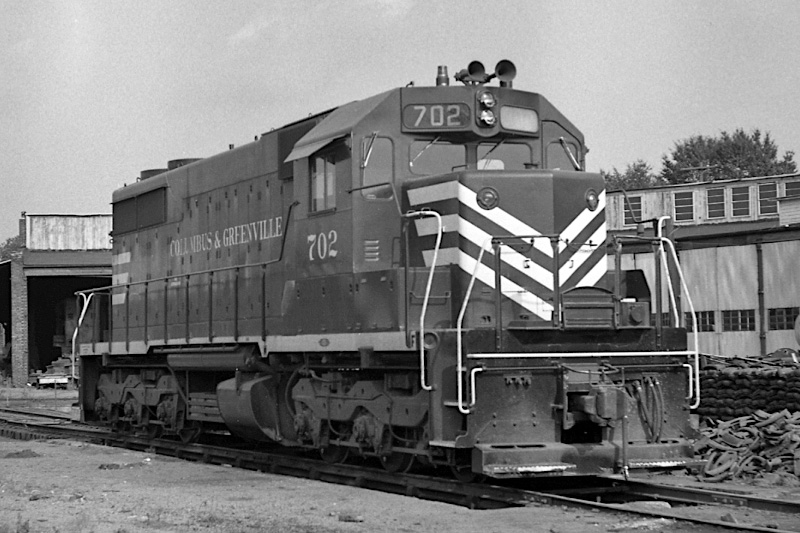
Columbus & Greenville #702
Columbus, Ms / Dec 1969 / JCH


Columbus & Greenville #702
normally aspirated, no turbo
to Illinois Central Gulf #9451, 1973
to Illinois Central #9451, wrecked


this locomotive also posted in illinois central gulf motive power
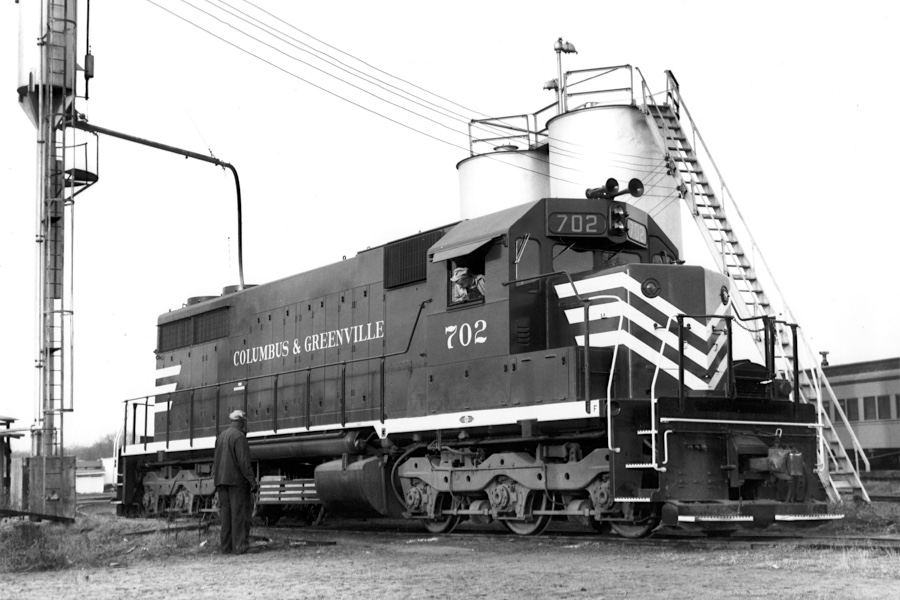
Columbus, Ms / Dec 1965 / Gil Hoffman

from TRAINS
magazine - Mar 1966 / collection
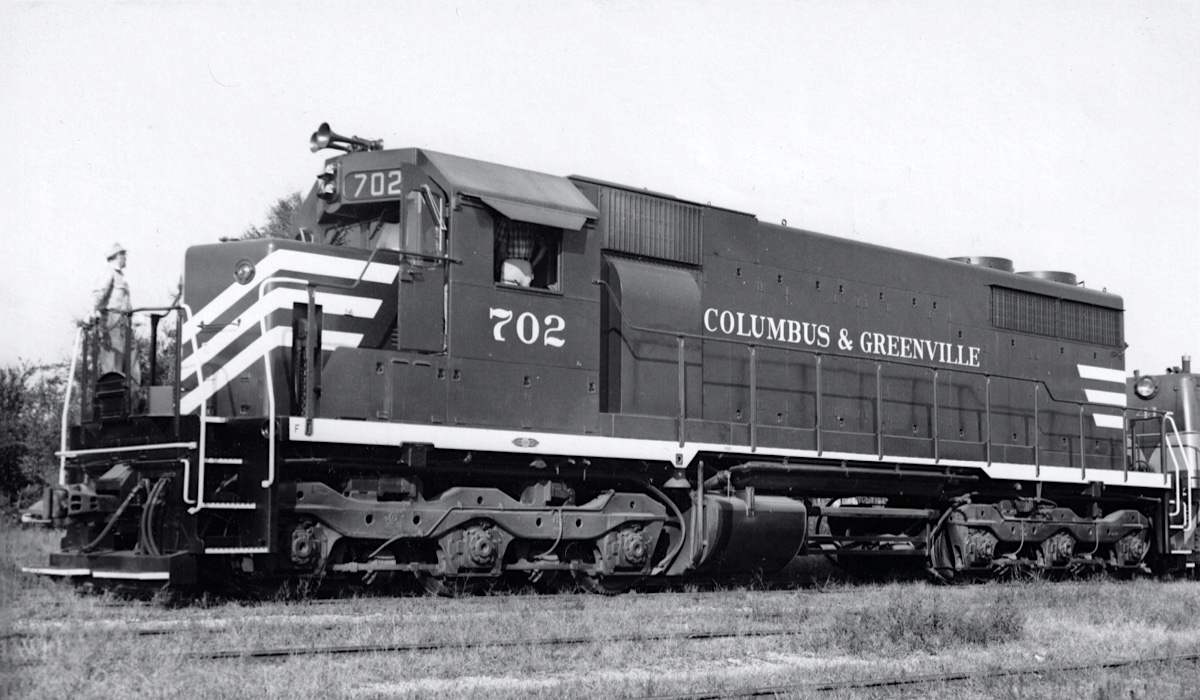
Columbus, Ms / Feb 1966 / collection

Columbus, Ms / Jun 1970 / JCH

Columbus, Ms / Jun 1970 / JCH
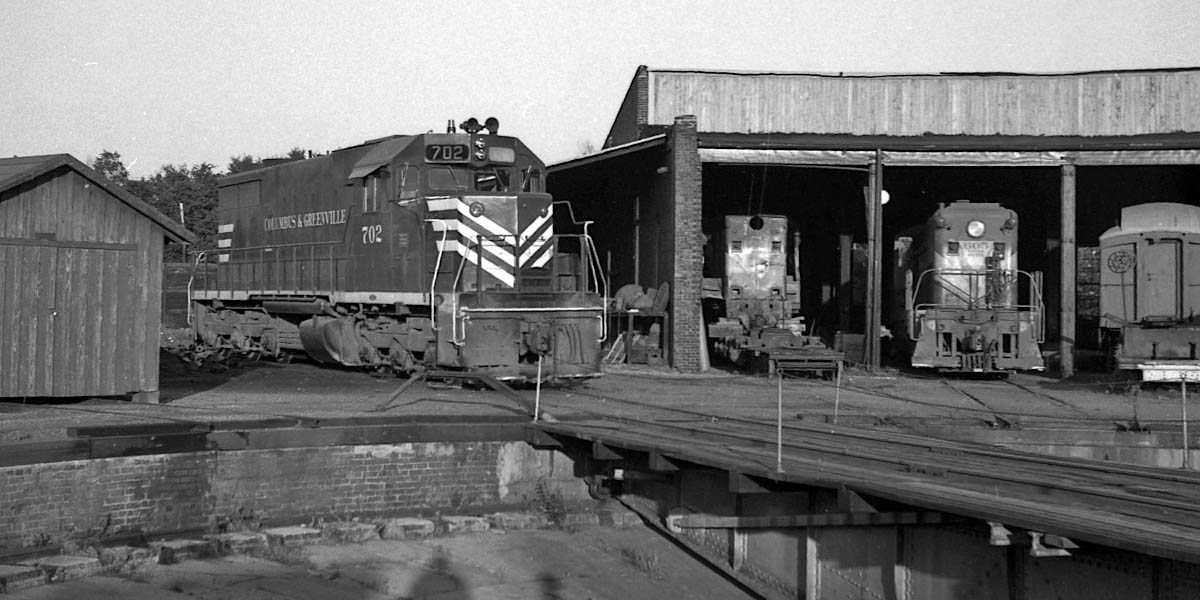
Columbus, Ms / Jun 1970 / JCH
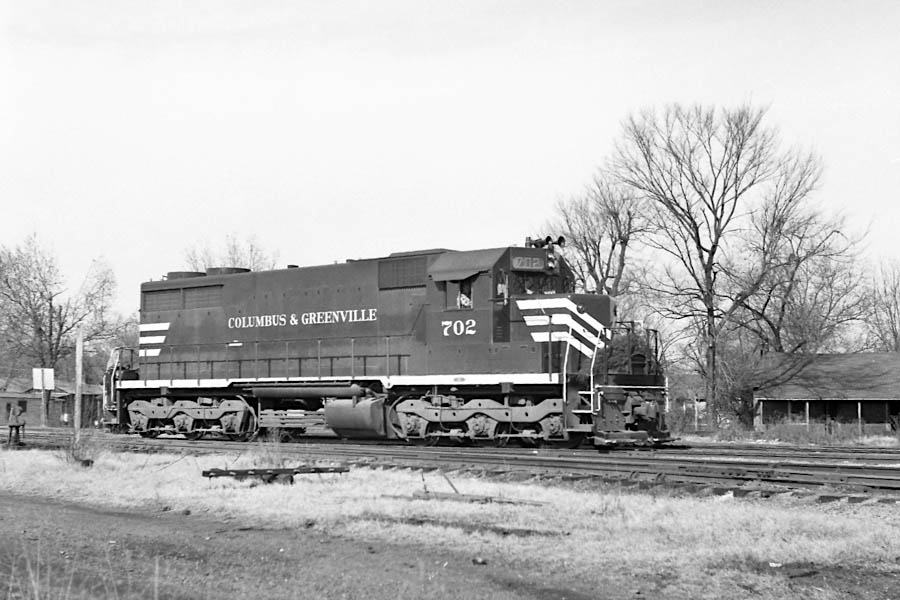
Columbus, Ms / Dec 1969 / JCH
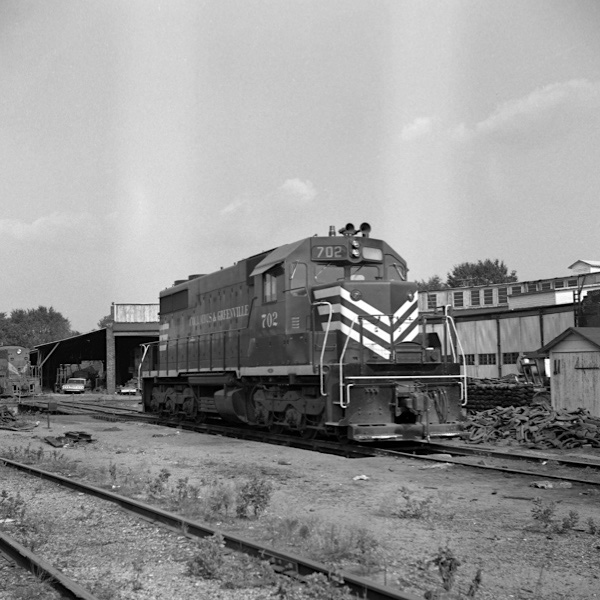
Columbus, Ms / Jul 1972 / JCH
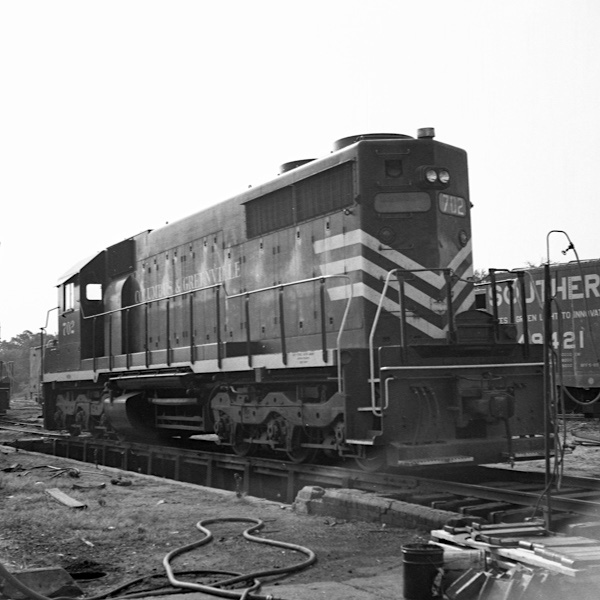
Columbus, Ms / Jul 1972 / JCH

Columbus, Ms / Jul 1971 / JCH
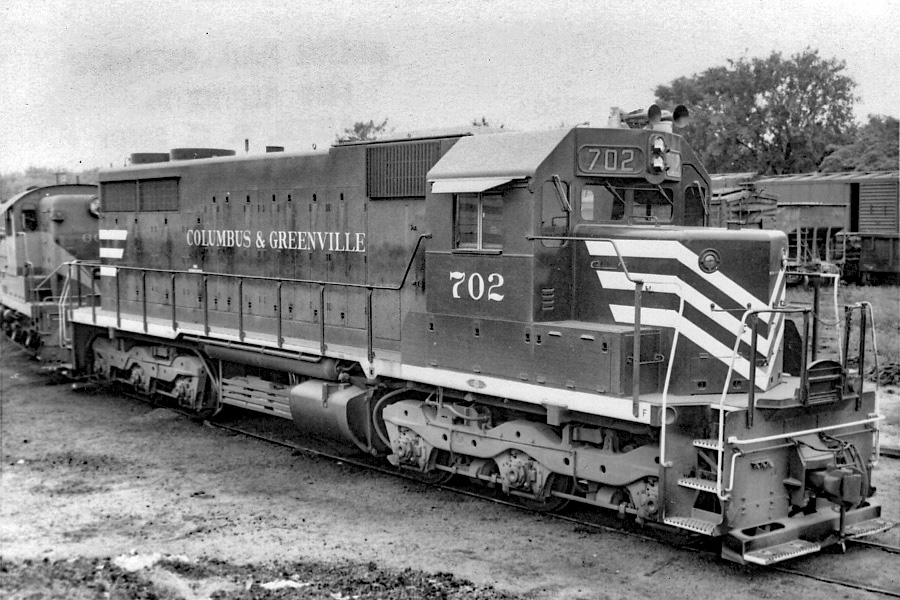
Columbus, Ms / Sep 1967 / collection

Columbus, Ms / collection
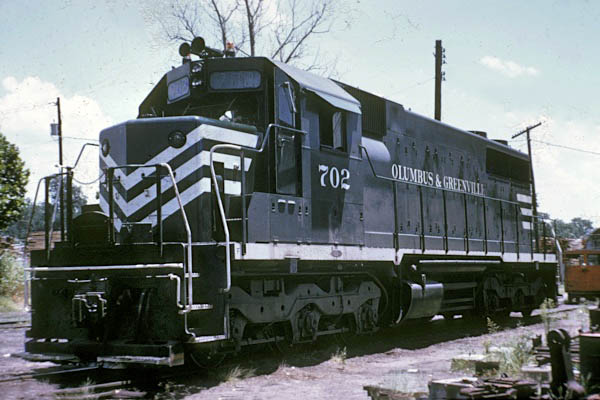
Columbus, Ms / 1973 / collection

Columbus, Ms / Mar 1973 / collection
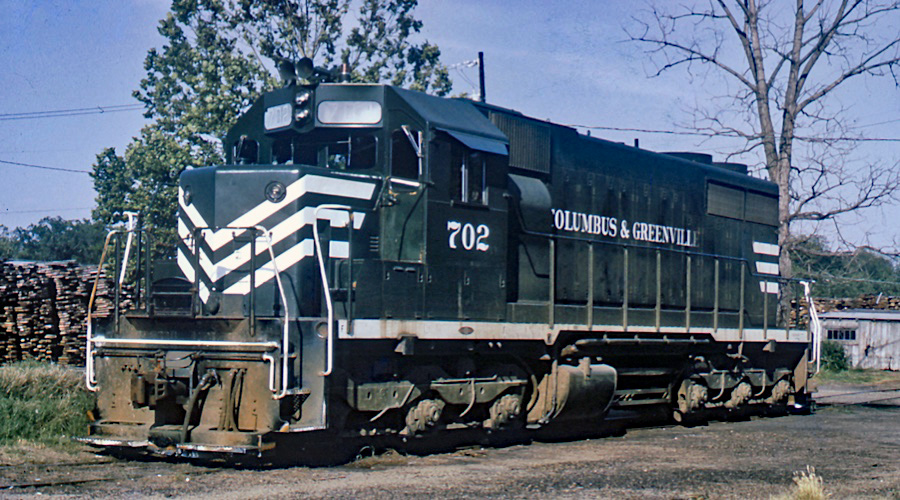
Greenville, Ms / 1970 / collection

Kansas City, Mo / Dec 1981 / collection

Illinois Central #9451
Carbondale, Il / 1989 / Gary Lee Todd

As for the SD28's, the Illinois Central Gulf operated them for many years and I believe I photographed both of them in service on the railroad. One was subsequently wrecked and scrapped. The other went through the hands of a second hand dealer, who thought to offer it to Roger Bell, President of the Columbus & Greenville, of all people. Roger told me he seriously considered buying the thing (mostly for old times sake) but thought better of it. I don't know which one it was, or whatever happened to it.
Louis Saillard
 Lagniappe
Lagniappe
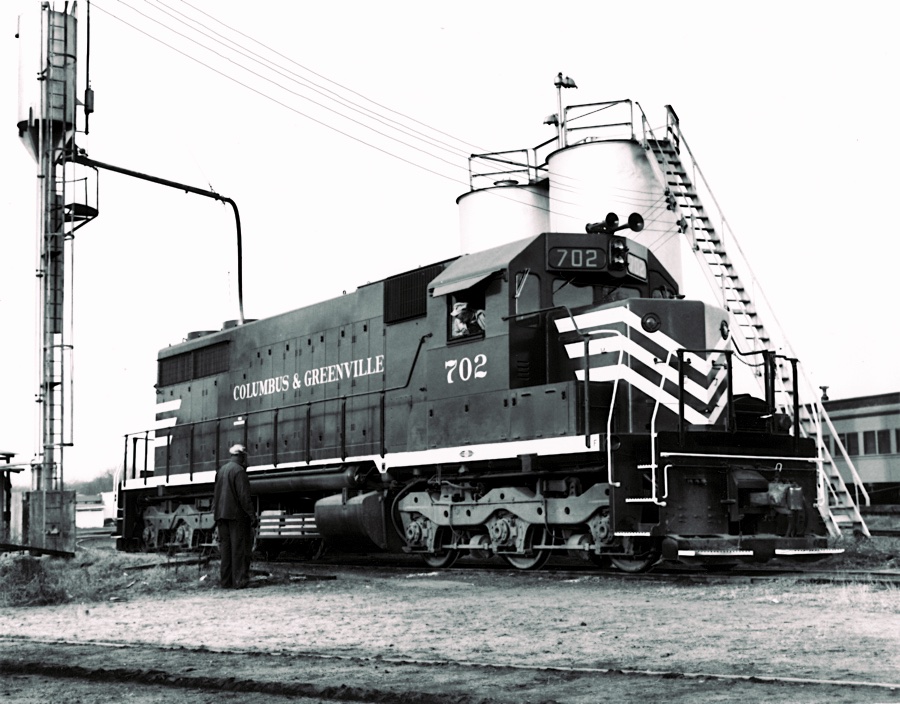
Special Duty Morning
Columbus, Ms / Dec 1965 / Gil Hoffman photo / collection

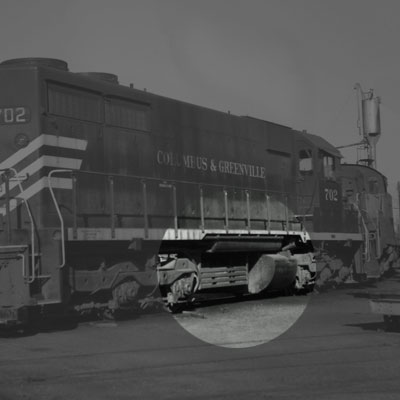 When you operate 175 miles of 10-15 mph trackage, much of it 60 or 70 pound rail dating back over too many decades, you have to find ways to save weight on your equipment so as to not threaten your bridges and trackwork on every outing.
When the C&G ordered its sturdy, modern SD28s in 1965, what it needed more than plenty of fuel was plenty of space to store jacks, blocks, and all the equipment needed to rerail equipment. All this, plus a way to save weight in the process.
As such, the C&G opted for small, 1000 gallon tanks, making use of the extra space under the frame for a steel cage to hold the equipment necessary to keep an aging line in business.
As Louis Saillard notes in his history, this was a "touch of the home-spun on an otherwise
business-like locomotive which warmed the heart of many a shortline railroad enthusiast." For me, the old C&G epitomized the scrappy, born-of-necessity outlook of many deep south shortlines, who modified equipment and did what had to be done to
keep trains rolling over even the worst of trackage and worn-out roadbed.
When you operate 175 miles of 10-15 mph trackage, much of it 60 or 70 pound rail dating back over too many decades, you have to find ways to save weight on your equipment so as to not threaten your bridges and trackwork on every outing.
When the C&G ordered its sturdy, modern SD28s in 1965, what it needed more than plenty of fuel was plenty of space to store jacks, blocks, and all the equipment needed to rerail equipment. All this, plus a way to save weight in the process.
As such, the C&G opted for small, 1000 gallon tanks, making use of the extra space under the frame for a steel cage to hold the equipment necessary to keep an aging line in business.
As Louis Saillard notes in his history, this was a "touch of the home-spun on an otherwise
business-like locomotive which warmed the heart of many a shortline railroad enthusiast." For me, the old C&G epitomized the scrappy, born-of-necessity outlook of many deep south shortlines, who modified equipment and did what had to be done to
keep trains rolling over even the worst of trackage and worn-out roadbed.
 Scrapbook
Scrapbook

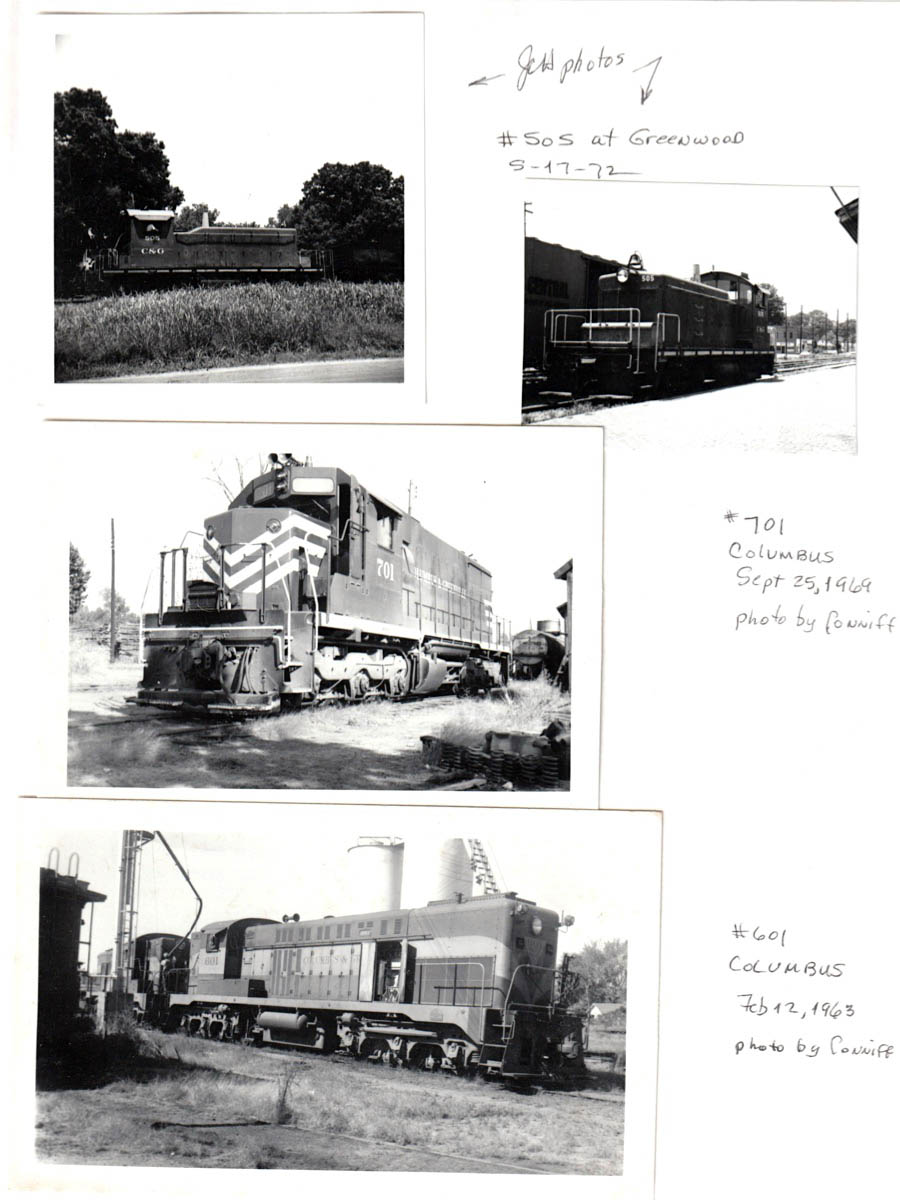
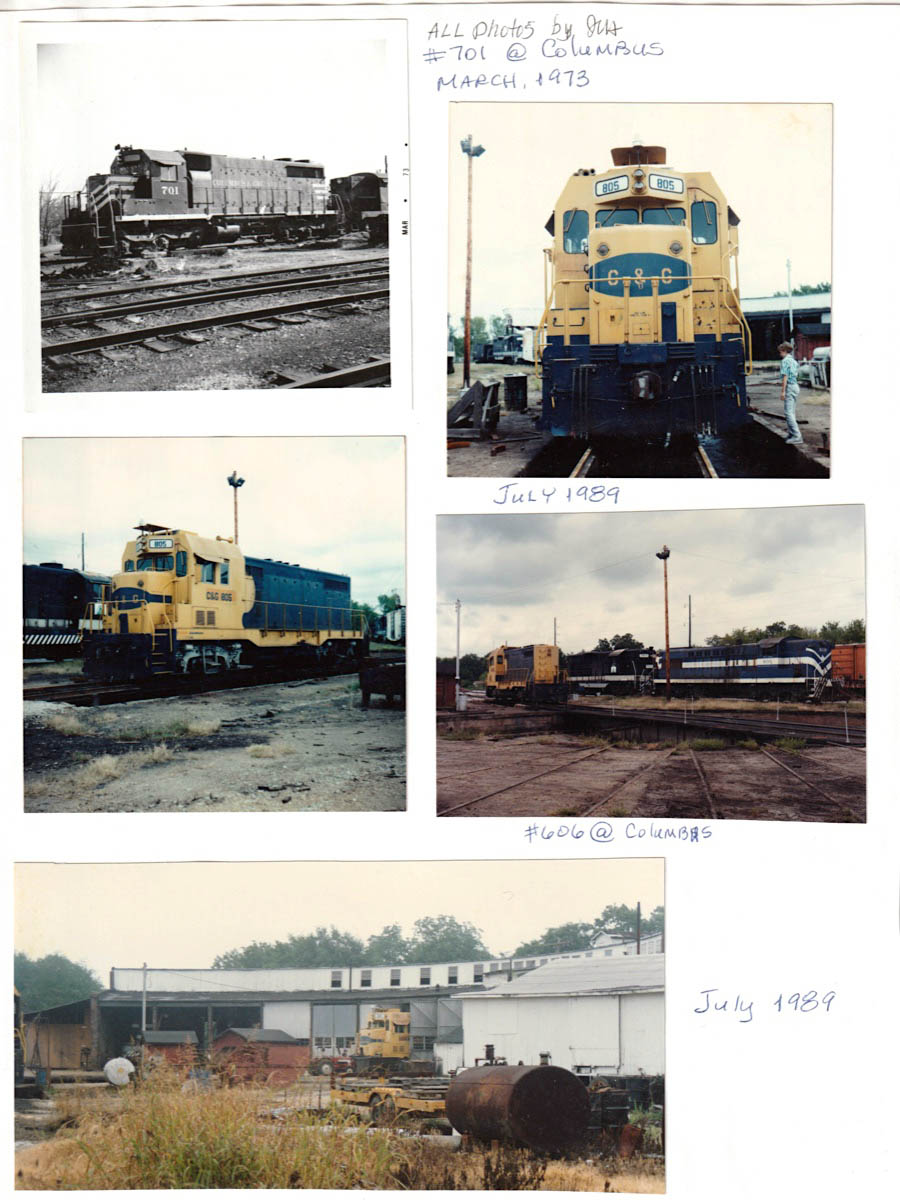
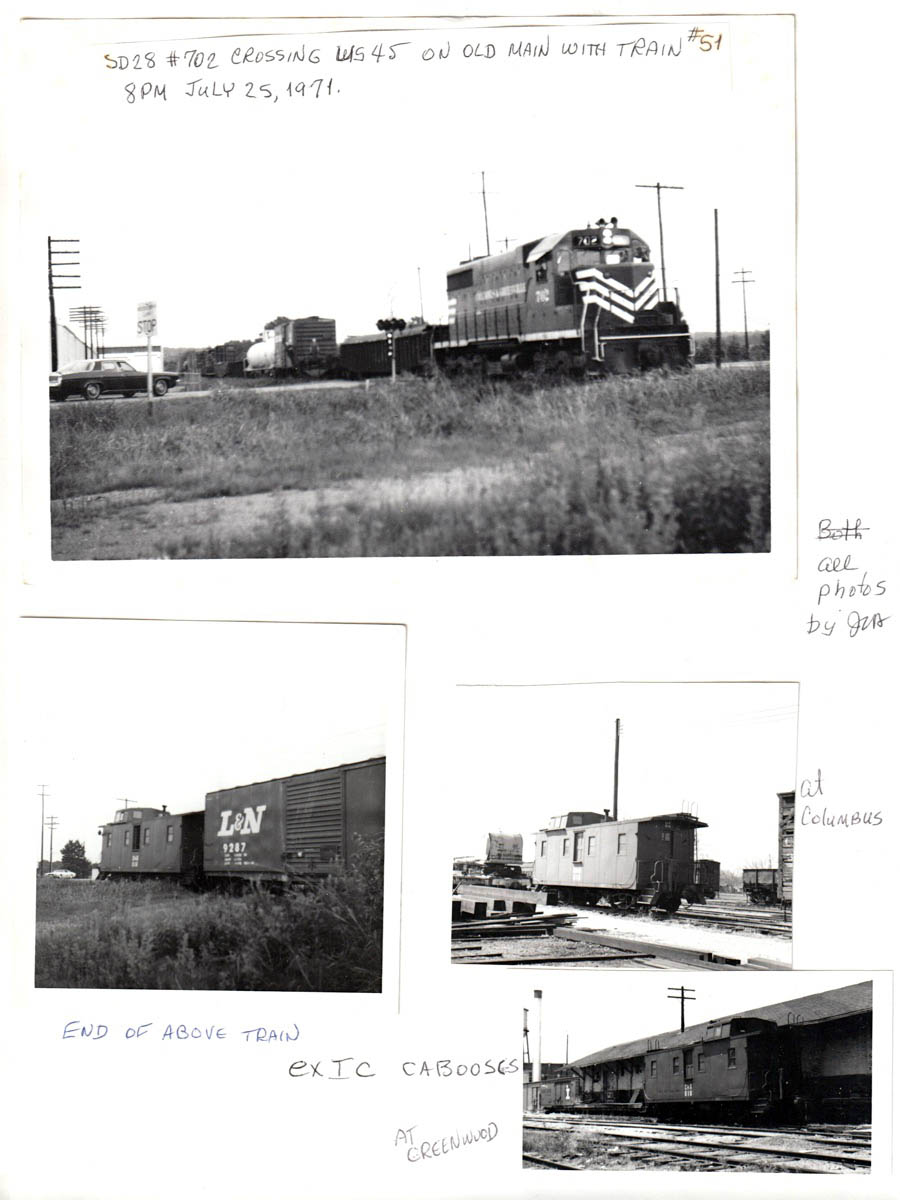

all pages from Columbus & Greenville scrapbook / JCH
Links / Sources
- Louis R. Saillard, Delta Route: A History of the C&G Railway (1981) 74, 104
- Jerry Pinkepank, The Second Diesel Spotter's Guide (Kalmbach, 1974) 74
- Diesel Shop roster for Columbus & Greenville
- Railroad Picture Archives Columbus & Greenville SD28 roster
- Wikipedia article for EMD SD28 model

 Nos. 701 and 702 served the Delta Route quite well, allowing for increased train tonnage leaving Columbus and shorter travel times for movements across the state. In fact, it is quite likely that these two locomotives would have enjoyed a long career on the Mississippi shortline, except for an ill-timed wreck and the coming
Nos. 701 and 702 served the Delta Route quite well, allowing for increased train tonnage leaving Columbus and shorter travel times for movements across the state. In fact, it is quite likely that these two locomotives would have enjoyed a long career on the Mississippi shortline, except for an ill-timed wreck and the coming 

